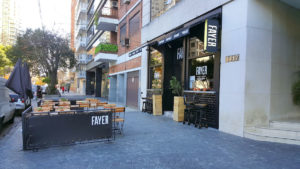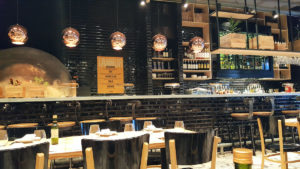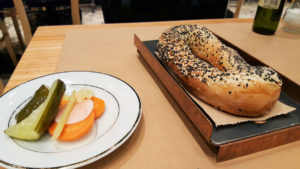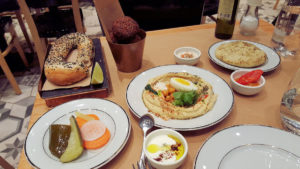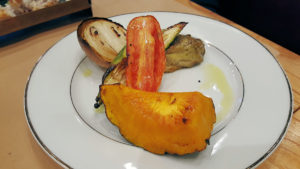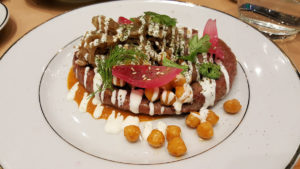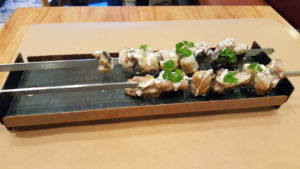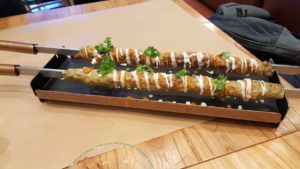One of my favorite restaurants in Buenos Aires is Mishiguene, the modern Israeli creation from chef Tomás Kalika. Styled as “cocina de inmigrantes”, or immigrant cooking, it’s a paean to classic dishes of both the sephardic and ashkenazic Jewish traditions, modernized, with twists, turns, and twinings. It’s a place that I regularly send people to who want something different from the usual suspects of Argentine cuisine, and with only one exception I can think of, everyone’s loved it.
[Edit: I just found out, next day, that as of June 6th, just three weeks before I wrote this up, Tomás and his partner Javier sold out their ownership and involvement with Fayer to concentrate on Mishiguene and a new project he’s been working on called Project Diaspora, exploring the changes in Jewish cuisine as it has moved into different parts of the world.]
Enter, his second restaurant, Fayer, Av. Cerviño 4417, Palermo, opened quite a few months back. It may even be a year now, I just hadn’t made it there until the last week or two. I’ve been twice now, once solo and once with Henry.
It’s a pretty room, a mix of light wood, glass, and a lot of copper. There’s an open kitchen at the back, and a big wood fired oven behind the bar (which doesn’t seem to be in use, at least at lunchtime, which is when I visited both times. Service is friendly, though inconsistent.
On the first visit, a Saturday, with a nearly full room, there was only one waitress handling the entire restaurant, with a busboy, and, following in Mishiguene’s footsteps, they don’t have a daytime bartender, so she was also mixing all the drinks. You’d think the manager, who basically spent most of the lunch hour hanging out at the front door playing with his pencil, could have at least jumped in and helped there. Once or twice he helped her carry some things to the tables. At one point, though, she got wrapped up in trying to make one of their specialty cocktails and spent a solid ten minutes behind the bar – clearly reading instructions on how to make it, and had to throw it out and start over twice. Same as my feelings at Mishiguene, if you’re not going to have a bartender on staff during lunch, just don’t offer cocktails as an option at that time of day – stick with wine and beer only.
On the second visit, a Monday, there were two waiters on duty, and a room with no more than a dozen people in it, so service was much smoother, though inexplicably, one of the waiters kept speaking to Henry and I in English, despite the fact that we were talking in Spanish, and answering him in Spanish, I finally asked him to speak in Spanish and he seemed shocked.
Every table gets a “bagel” and some pickles. Like the bagel at Mishiguene, this isn’t really what I think of as one. It’s a soft bread roll shaped in a ring – an oblong, racetrack shaped ring – but it’s not really a bagel, the crust is as soft as the insides. Apparently these are a “thing”, a “Jerusalem bagel”. It’s delicious. As are the pickles.
While Mishiguene focuses on really modern, interesting takes on a mix of cuisines from the Jewish traditions, Fayer is more focused on the Middle Eastern dishes, and while beautifully presented, I’d venture that they’re less about modernization and more about simply high quality. I came away from both visits with a slight disappointment that the dishes aren’t cutting edge reinterpretations of the classics, but happy with most everything we ate. At the same time, that’s probably unfair, because Fayer doesn’t promise that, it’s about “fire”, which is what fayer translates as from Yiddish. Pretty much everything comes off of or out of, open flame.
And flame can be hard to control. While a lovely copper cup was filled with half a dozen really tasty, well spiced falafel, they were also cooked so dark as to be verging on burnt (190 pesos, $7). The three sauces accompanying them – a yogurt sauce, a tahini sauce, and a fiery harissa, were all delicious, and I kept the harissa sauce for use on my main course, and on the day Henry and I visited, asked for a dish of it on the side. A plate of hummus was excellent, well made, though one mini pita bread, maybe three inches across, isn’t exactly enough for that much of it (140 pesos ($5) for a half order, 240 ($9) for a full order – that’s expensive hummus). The bagel ended up filling in.
A plate of roasted vegetables was quite good – with a selection of squash, eggplant, zucchini, tomato, and onion, but again, 140 pesos is a bit steep for that – $5 isn’t really, on an international scale, but seems it here – I guess after 13 years here, it’s still a bit difficult to grasp how prices have changed here – a plate like that when I moved here would have probably cost the equivalent of about 75 cents, which yes, I realize, was artificially low because of the economic collapse, but is still the reality for many of us who’ve been here for awhile.
An excellent housemade merquez sausage, with confited onions, chickpeas, yogurt (really, labneh), and their “shishlik” sauce, which is never defined on the menu, but is a vaguely smoky red sauce, maybe roasted bell peppers? Delicious. 300 pesos ($11).
There are two offerings of shishlik, skewered meats, either beef or fish. The fish on offer was anchovy – a single large one to each of two skewers. Beautifully cooked and smoky – we don’t see large anchovies here a lot. A little disappointment that the only thing on the skewers is the fish – I’m used to seeing these sorts of brochettes with at least a little bit of vegetable interleaved – some onion, some pepper, something, but that may not be traditional. Also, interesting that it didn’t come with the shishlik sauce, but rather with the labneh – I mean, isn’t the purpose of the shishlik sauce to be served on or with the shishlik? 520 pesos, or $19, seems outrageous for a main course, but truthfully, if you get a vegetable side (either the one above, or one of their other selections), this is really a shareable dish for two – I could barely finish it.
The only true disappointment, the chicken kebabs (also available in beef). The other “disappointments” above are minor things that I just think would improve them. This was just plain not to our tastes at all. The kebab meat was so densely packed around the skewers, and so over cooked, that it was dry, and was so stuck to the skewers that our waitress had to basically chip it away from them, leaving a an unappetizing jumbled pile of what ended up looking like chopped up meatballs. It was also so overwhelmingly onion-y, that you couldn’t taste much of anything else. Even with me trying a piece or two, he barely ate one of the two. And, like the dish above, it’s really a dish meant for two – something in both cases I think either the menu should say, or the waiters should when it’s ordered. 340 pesos ($12.50).
So, the wrap up. Beautiful room. Inconsistent, but friendly service – actually, if the waiters at lunch didn’t get tied up with bar related duties, it would probably be just fine. The food, good, actually, other than the chicken kebabs, really good, even if not what I’d envisioned. It is pricey (and add in a 60 peso/person cubierto charge), but then so are a lot of places these days, and it’s been almost a year since I’ve been back to Mishiguene, I have no doubt their prices have gone up significantly this last year. Fayer is certainly recommended, though I’m more likely to return to Mishiguene.
